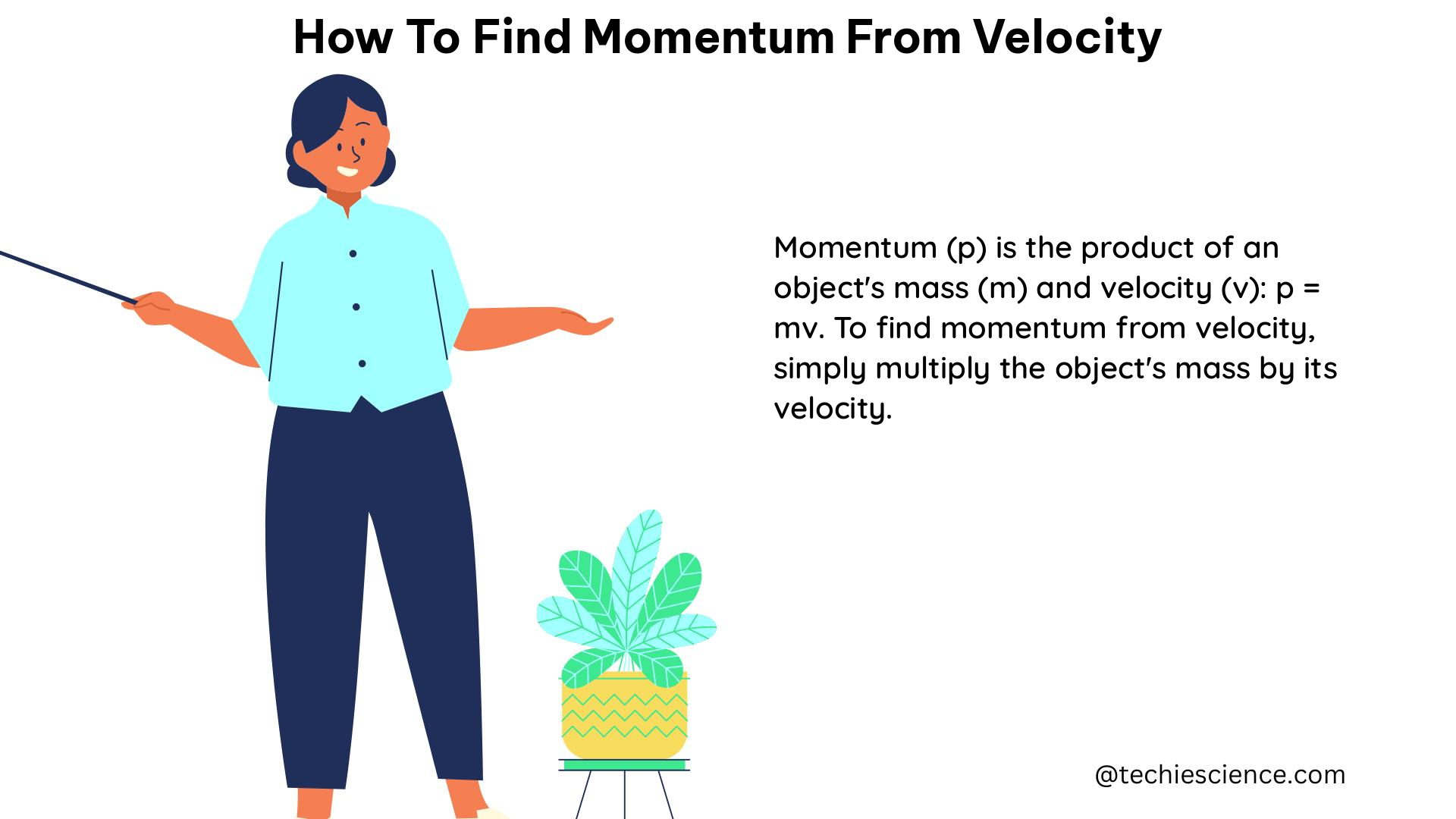Momentum is a fundamental concept in physics that describes the quantity of motion possessed by an object. It is a vector quantity, meaning it has both magnitude and direction. To find the momentum of an object, you need to know its mass and velocity. In this comprehensive guide, we will explore the various aspects of finding momentum from velocity, including the underlying physics principles, mathematical formulas, and practical examples.
Understanding Momentum
Momentum is defined as the product of an object’s mass and its velocity. The formula for momentum is:
$p = mv$
Where:
– $p$ is the momentum of the object
– $m$ is the mass of the object
– $v$ is the velocity of the object
The standard unit of momentum is the kilogram-meter per second (kg·m/s). However, other units can also be used, such as gram-centimeter per second (g·cm/s) or kilogram-kilometer per hour (kg·km/h).
Calculating Momentum in One Dimension

To find the momentum of an object moving in one dimension, you can simply multiply the object’s mass by its velocity. For example, if an object with a mass of 5 kg is moving at a velocity of 10 m/s, its momentum would be:
$p = mv$
$p = 5 \times 10$
$p = 50 \text{ kg·m/s}$
Momentum in Two Dimensions
When dealing with momentum in two dimensions, you need to break down the momentum into its component directions (x and y). The equations for this are:
$p_x = m \times v_x$
$p_y = m \times v_y$
Here, $p_x$ and $p_y$ represent the momentum in the x and y directions, respectively, and $v_x$ and $v_y$ are the velocity components in those directions.
Conservation of Momentum
Momentum is a conserved quantity, meaning that the total momentum of a closed system remains constant unless there is an external force acting on it. This is expressed by the equation:
$F = \frac{dp}{dt}$
Where $F$ is the net force acting on the system and $\frac{dp}{dt}$ is the rate of change of momentum.
Example Problem in Two Dimensions
Suppose you have two objects, one with a mass of 0.6 kg and the other with a mass of 0.6 kg. The first object is moving at 0 m/s, and the second object is moving at 5 m/s. After a collision, the first object moves at an unknown velocity. To find the final velocity of the first object, you can use the conservation of momentum.
- Identify the masses and velocities of the objects.
- Break down the momentum into its component directions.
- Use the conservation of momentum to solve for the unknown velocity.
For example, in the y-direction:
$0 + 0.6 \times 5 \times \sin(10) = 0.6 \times v_1 \times \sin(-15) + 0.6 \times 5 \times \sin(10)$
Solving for $v_1$:
$v_1 = \frac{0.6 \times 5 \times \sin(10)}{0.6 \times \sin(-15)}$
$v_1 = 3.3544 \text{ m/s}$
Advanced Concepts
Relativistic Momentum
In the realm of special relativity, the formula for momentum needs to be modified to account for the effects of high-speed motion. The relativistic momentum formula is:
$p = \gamma mv$
Where $\gamma$ is the Lorentz factor, given by:
$\gamma = \frac{1}{\sqrt{1 – \frac{v^2}{c^2}}}$
Here, $c$ is the speed of light.
Quantum Mechanical Momentum
In quantum mechanics, the momentum of a particle is related to its wavelength through the de Broglie equation:
$p = \frac{h}{\lambda}$
Where $h$ is Planck’s constant and $\lambda$ is the wavelength of the particle.
Practical Applications
Momentum is a crucial concept in various fields of physics, including:
- Mechanics: Understanding the motion of objects, collisions, and the conservation of momentum.
- Astrophysics: Analyzing the motion of celestial bodies and the momentum exchange in astronomical phenomena.
- Particle Physics: Studying the momentum of subatomic particles and its role in particle interactions and accelerator experiments.
- Engineering: Designing systems and devices that involve the transfer of momentum, such as in the design of vehicles, machinery, and sports equipment.
Conclusion
Mastering the concept of momentum and its relationship with velocity is essential for a deep understanding of physics. By following the principles and equations outlined in this comprehensive guide, you can confidently calculate the momentum of objects in both one-dimensional and two-dimensional scenarios, as well as explore more advanced topics like relativistic and quantum mechanical momentum. With this knowledge, you can tackle a wide range of physics problems and gain a deeper appreciation for the fundamental laws governing the motion of the physical world.
References
- Khan Academy. (2010). Introduction to momentum (video). Retrieved from https://www.khanacademy.org/science/physics/linear-momentum/momentum-tutorial/v/introduction-to-momentum
- Calculatorsoup. (2023). Momentum Calculator p = mv. Retrieved from https://www.calculatorsoup.com/calculators/physics/momentum.php
- Study.com. (2021). Using the Conservation of Momentum to Find a Final Velocity in 2 Dimensions. Retrieved from https://study.com/skill/learn/using-the-conservation-of-momentum-to-find-a-final-velocity-in-2-dimensions-explanation.html
- Hyperphysics. (n.d.). Relativistic Momentum. Retrieved from http://hyperphysics.phy-astr.gsu.edu/hbase/relativ/relmom.html
- Quantum Mechanics. (n.d.). de Broglie Wavelength. Retrieved from https://www.quantum-mechanics.org/de-broglie-wavelength.html

The lambdageeks.com Core SME Team is a group of experienced subject matter experts from diverse scientific and technical fields including Physics, Chemistry, Technology,Electronics & Electrical Engineering, Automotive, Mechanical Engineering. Our team collaborates to create high-quality, well-researched articles on a wide range of science and technology topics for the lambdageeks.com website.
All Our Senior SME are having more than 7 Years of experience in the respective fields . They are either Working Industry Professionals or assocaited With different Universities. Refer Our Authors Page to get to know About our Core SMEs.